Here are the recommended Greenkeeping tasks for August maintenance work for the Performance Greens Program.
 August is upon us and the days are shortening noticeably already. Thought’s might already be turning to autumn and the plan for renovations of the green. My Greencraft Column in Bowls International this month explains how you can assess your green and make the right decisions for autumn renovation works.
August is upon us and the days are shortening noticeably already. Thought’s might already be turning to autumn and the plan for renovations of the green. My Greencraft Column in Bowls International this month explains how you can assess your green and make the right decisions for autumn renovation works.
With the autumn work planned properly, we take it easy and apply ourselves to another 2 months of bowling at least before we have to think about that again.
The weather has been a bit haphazard and this is causing all sorts of problems for clubs up and down the UK. For many greens suffering at the hands of Localised Dry Patch (LDP), the rains have come too late and it’s imperative to take some positive action to recover the wet-ability of the soil now. With that in mind I’ll start off by repeating last months advice on dealing with LDP.
I’ll repeat the identification help for these at the end of this month’s greenkeeping advice.
Localised Dry Patch and Fairy Ring
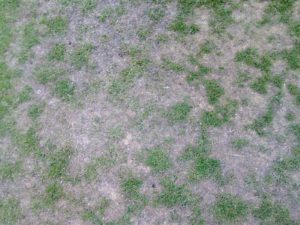 If your green is susceptible to Localised Dry Patch, then it will undoubtedly have shown its ugly face on your green by now. The exceptionally dry weather in early spring has caused a lot of greens to dry out early on this season and where there is Hydrophobic soil due to excess sand, then it can be difficult to recover the situation mid season.
If your green is susceptible to Localised Dry Patch, then it will undoubtedly have shown its ugly face on your green by now. The exceptionally dry weather in early spring has caused a lot of greens to dry out early on this season and where there is Hydrophobic soil due to excess sand, then it can be difficult to recover the situation mid season.
This is something that needs to be tackled head on now, as it can be quite devastating to green performance if allowed to run on unchecked. If this is something your green is suffering from, there’s more detailed information about its causes and cures here.
Similarly, Fairy Ring problems are closely related in terms of soil conditions. More on dealing with Fairy Ring here.
Irrigation
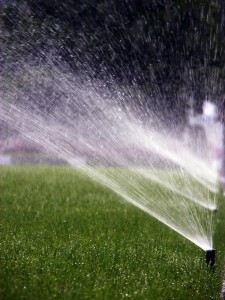
Now, when the green is obviously suffering from a lack of water in places it is tempting to turn up the irrigation timer, but over the last few weeks I’ve had quite a few enquiries related to over-watering.
In dry patch affected greens, it’s important not to over-water the areas that aren’t affected. This inevitable means a lot more hand watering of the hot spots and dry patches. It’s quite common for there to be a hot spot right in the middle of bowling greens due to the inherent design flaw of the standard, one sprinkler per side systems. This design doesn’t deliver enough water to the centre of the green in a lot of cases.
Hand watering of dry patch affected areas should continue alongside the dry patch treatments detailed in the links above.
Standard Irrigation Requirements
Meantime, you should continue to irrigate the green only as required based on the normal requirements.
Water losses to evapo-transpiration will be at least 25mm in a dry week, possibly much more in a very hot spell.
The average (one sprinkler per side) bowling green irrigation system gives out 1mm of water for every 2 minutes of run time.
This means that in a rainless week, you will need to aim to run your sprinklers for at least 50 minutes.
In reality, many systems are inadequate and applying 50 minutes of irrigation accurately in a week is pretty difficult due to storage capacity, sprinkler coverage etc.
Some allowance for hand watering of dry areas will be required.
More on accurate irrigation management in Performance Bowling Greens
Mowing
Mowing frequency should continue at summer level of 3 cuts or more per week by now. During very dry spells you should alter your mowing regime to take account of the needs of the grass plants. I laid out some ideas for that in June’s program here.
The critical advice with mowing as always is keeping the blades sharp and keeping settings free and accurate.
Mowing height can be raised slightly in very dry weather to allow the plants to retain more green tissue. This will aid water retention and allow more efficient photosynthesis and respiration
Micro Nutrients
Micro nutrients or trace elements are particularly important when grass is under stress so I recommend continued use of Super Concentrated Seaweed Liquid with its plethora of trace elements and natural plant inoculants. Trace elements like Copper and Zinc are known to help grass plants fend off attacks from fusarium and other fungal pathogens and its bio-stimulant properties helps to keep the microbe population growing and active. You can quite happily apply this all year round as a bio-stimulant.
Scarifying/Verti-cutting-skip the dry bits!
On recovering greens (still thatchy and in the Circle of Decline) I would normally recommend continued verti-cutting through the summer, but again very dry conditions should be the exception to this as it does have a drying out effect on the turf.
It is important that there is sufficient growth to support the recovery, so hold off on this if you aren’t seeing that yet either.
When conditions are suitable a light verti-cut twice a month can really help with keeping thatch build up under control.
For this operation the blades should barely be touching the soil as the main purpose is to slice through stolons (encouraging vegetative reproduction) and teasing up lateral growth.
Some clubs are seeing a variation in growth pattern across the green due to dry patch, so, a bit like the watering situation, you might have to be selective with this too. Verti-cutting the green bits and missing the brown.
Adding and Boosting Soil Microbes for under £5 a time
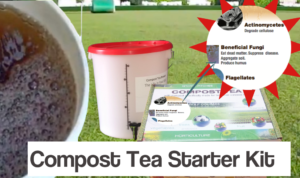 Whether your green is drought stressed or not, but more especially if it is, this is the optimum time to get started on a Compost Tea program.
Whether your green is drought stressed or not, but more especially if it is, this is the optimum time to get started on a Compost Tea program.
Here’s the Intensive Compost Tea regime I recommend for greens that are struggling
Brewing and Re-Brewing Compost Tea
- Split the Compost, Nutrients pack and Activator pack 4 ways (8 ways for the 24 brew pack) and store carefully.
- Add 1 batch of each of these to the Tea Bag
- Add 50g of the Fungal additive (this is enough for soil Organic Matter of 6.0 and above, but add more (75-100g) if your green is very sandy) to the tea bag
- Continue as per instructions in manual.
Bio Stimulants
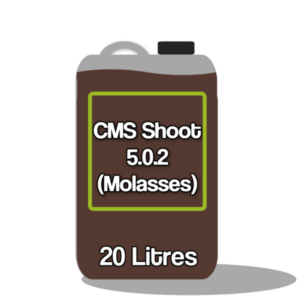 Plants and microbes both need carbon, nitrate, phosphate, carbohydrate and sugars; some bio-stimulants provide all or some of these elements, whilst others provide a substrate on which plant and soil microbes survive to make these elements available to enhance the growth of the plant.
Plants and microbes both need carbon, nitrate, phosphate, carbohydrate and sugars; some bio-stimulants provide all or some of these elements, whilst others provide a substrate on which plant and soil microbes survive to make these elements available to enhance the growth of the plant.
There are two main reasons for using bio-stimulants to improve the growth and health in bowling green turf.
First of these is simply to feed the soil microbiology because the organic substrate (humus) needed by soil microbes has been designed out of the rootzone specification. Our modern love for very sandy rootzones, means that many greens have too little humus and too much thatch.
Secondly, many bio-stimulants have a direct effect on the health of the plant. In perfect growing conditions, bio-stimulants will do little for plant health, but sports turf, especially bowls and golf greens and modern pitches are some of the most artificial environments created for plant growth and the grass plant benefits from the addition of the stimulants that it cannot produce in sufficient quantities itself.
More on the benefits of Bio-Stimulants here.
Nutrition and Fertiliser
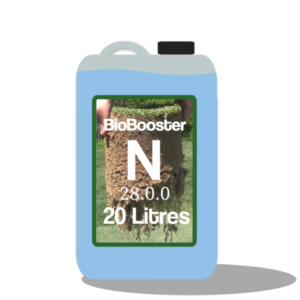 Greenkeeping tasks for June include managing nutrient supply well, as this is vital to creating a performance green surface that is consistent throughout the season. Peaks and troughs of growth are the enemy of green speed and smoothness.
Greenkeeping tasks for June include managing nutrient supply well, as this is vital to creating a performance green surface that is consistent throughout the season. Peaks and troughs of growth are the enemy of green speed and smoothness.
This is why it’s best to use Bio Liquids as the regular and light applications help to provide the required Nitrogen as it’s needed instead of encouraging flushes of growth all at once.
Bio Liquids also provide a boost of carbohydrate to the soil microbial population to help keep them growing and multiplying. Over time, this alone can reduce the need for fertiliser applications, as when your soil is firing on all cylinders the microbial activity within it can easily produce more than half of the green’s annual Nitrogen requirement on its own.
Aeration

Sarrel rolling continues to be the method of choice even when the soil is dry. It is also a very useful operation for letting irrigation into a crusted surface.
It keeps air movement going just sub-surface where the microbes roam too. You can do this as regularly as you want and it is a really useful pre-compost tea application job and a very useful way to get water and wetting agents through the crust of thatch build up.
Looking forward to Performance Greens
August is a good time to think about autumn renovation of the green.
This year, many clubs are coming round to the fact that they’ve been chasing symptoms for years and not tackling the underlying causes of poor green performance. Why not use the last third of the season to commit fully to achieving a Performance Bowling Green? The ebook that’s caused all the fuss is well under the price of a bag of fertiliser!…more here.
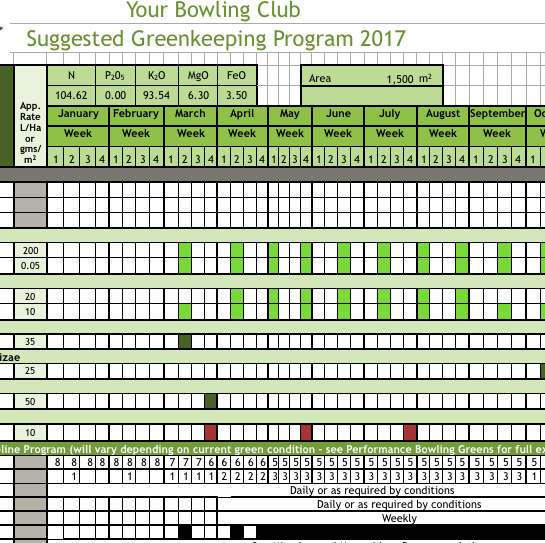
Your personal greenkeeping consultant.
In addition to absorbing the message in Performance Bowling Greens, why not let me do a soil analysis for you. I’ll send you a kit to take the samples and also ask you some questions about the physical condition of your green, photos etc.
I’ll follow this up with a detailed and comprehensive report, analysis of your soil results and a detailed greenkeeping program you can follow to improve your green.
More details of this unique service here.
Questions Please
Of course as always, if you have any questions comments or problems, please feel free to drop me a line.

Hi John,
I have been in touch with you several years ago while I was looking after my local bowling green in Rothey Leicestershire.
I moved 3 years ago to Soar Valley Bowls Club, still in Rothley.
I’m nothing to do with the maintenance of the green at the moment, but I’m banging my head against the wall trying to get the committee to understand some of the problems with the green.
There are lots of very dry areas on the green, probably 35%.
My main concern at the moment is the appearance of some rings on the green which have increased in size over the last 3 yrs. They started out with just one, roughly the size of a tea plate spreading to a dinner plate last season. There are now a dozen or more in different parts of the green but much larger, 2’ and joining up to others. There’s approximately a
2 1/2” band around the outside where the grass is bare. The person the the club has to look after the green thinks it’s fusarium but it’s nothing like that.
Any ideas what it might be? before I have another go at the committee.
I do have photos if it would help.
Regards
John Wilkinson
Soar Valley Bowl Club.
Hi John
Good to hear from you. Yes, please send me some photos to my usual email john@bowls-central.co.uk
Regards
John